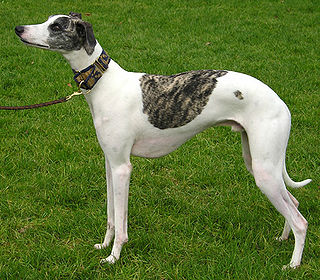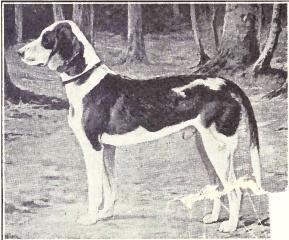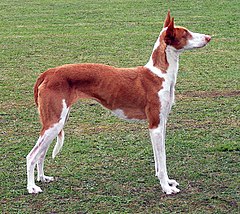
Sighthounds are a type of hound dog that hunts primarily by sight and speed, unlike scent hounds, which rely on scent and endurance.

The whippet is a British breed of medium-sized dog, of the sighthound type, related to the larger greyhound and the smaller Italian greyhound. Apart from the differences in height, the whippet closely resembles these two breeds; it has sometimes been described as "the poor man's greyhound". It is kept as a companion dog, for competitive showing, for amateur racing as well as lure coursing. It has the highest running-speed of any breed in its weight and size range, and may have the fastest idle-to-running acceleration of any dog.

The Pharaoh Hound or Kelb tal-Fenek is a Maltese breed of hunting dog. It is traditionally used for rabbit-hunting in the rocky terrain of the islands; the Maltese name means "rabbit dog".

A hound is a type of hunting dog used by hunters to track or chase prey.

Scent hounds are a type of hound that primarily hunts by scent rather than sight. These breeds are hunting dogs and are generally regarded as having some of the most sensitive noses among dogs. Scent hounds specialize in following scent or smells. Most of them tend to have long, drooping ears and large nasal cavities to enhance smell sensitivity. They need to have relatively high endurance to be able to keep track of scent over long distances and rough terrain. It is believed that they were first bred by the Celts by crossbreeding mastiff-type dogs with sighthounds. The first established scent hounds were St. Hubert Hounds bred by monks in Belgium during the Middle Ages.
Lure coursing is a sport for dogs that involves chasing a mechanically operated lure. Competition is typically limited to dogs of purebred sighthound breeds. The AKC has a pass/fail trial for all breeds called the Coursing Ability Test (CAT) and a timed 100 yard dash called Fast CAT where the dog's speed is converted to points.

The Saarlooswolfdog is a wolfdog breed originating from the Netherlands by the crossing of a German Shepherd with a Siberian grey wolf in 1935. The offspring were then further crossed with German Shepherds.

The Alpine Dachsbracke is a small breed of dog of the scent hound type originating in Austria. The Alpine Dachsbracke was bred to track wounded deer as well as boar, hare, and fox. It is highly efficient at following a trail even after it has gone cold. The Alpine Dachsbracke is very sturdy.

The Grand Basset Griffon Vendéen or GBGV is a dog breed from France.

The United Kennel Club (UKC) is a kennel club founded in 1898 in the United States. In contrast with the American Kennel Club, which is non-profit and which only clubs can join, the United Kennel Club is a profit-making corporation, open to individuals.

The Drentsche Patrijshond is a versatile spaniel-type hunting dog from the Dutch province of Drenthe. Called the Dutch Partridge Dog in English, approximately 5,000 dogs are registered with the breed club in the Netherlands, and breed clubs operate in Belgium, Denmark, Scandinavia and North America. The Drentsche Patrijshond bears some resemblance to both spaniel and setter types of dog. An excellent pointer and retriever, this dog is often used to hunt fowl and adapts equally well to the field or marshes.

The Petit Basset Griffon Vendéen, or PBGV, is a breed of dog of the scent hound type, bred to trail hares in bramble-filled terrain of the Vendée district of France. The breed is known in the United States as "Petit" or "PBGV," in England as "Roughie," and in Denmark as "Griffon" or "Petit". The PBGV is one of six types of "basset"-type breeds recognised by the Fédération Cynologique Internationale (FCI).

The Portuguese Podengo, also known as the Podengo Português or Portuguese Warren Hound, is a hound breed from Portugal. As a breed, the Podengo is divided into three size categories that are not interbred: small (Pequeno), medium (Médio) and large (Grande). Their coats are either short and 'smooth', or longer and 'wired'. The smooth coated variety is traditional, whereas the wire coated variety is an outcome of the assimilation of various other breeds during the 20th century. In general, the breed is healthy; the Pequeno (small) variety has an average lifespan of approximately 15–17 years.

Danish–Swedish farmdog is a breed of dog that has its origin in Denmark and southern Sweden, but has become popular all over Scandinavia. It is a native breed which has historically lived on farms in the eastern part of Denmark and southernmost part of Sweden, serving as a guard dog, rat catcher and hunting dog. The breed's soft and gentle temperament also makes them excellent companion dogs. There are some indications that the breed originates from the pinscher breeds and the British white hunting terriers.

Championships are awarded to dogs who have passed through a process of selection at dog shows. Traditionally, a championship was received at a conformation show, but championships are now offered for dogs who have attained a high degree of perfection in other dog sports as well.

Podenco Canario is a breed of dog from the Canary Islands. The Podenco Canario is still used today, primarily in packs, most often for the sport hunting of rabbits. The word "podenco" in Spain refers to a certain type of dog, typically rabbit hunters with the same body shape. "Canario" is a reference to its region of origin, the Canary Islands. The Spanish Kennel Club, Real Sociedad Canina de España, recognises the following similar dog breeds that use the identifier "podenco" in their names: Podenco Andaluz, Podenco Ibicenco, and Podenco Valenciano.

The Westphalian Dachsbracke is a small, short-legged scenthound, a breed of dog originating in Westphalia, a region of Germany. The Westphalian Dachsbracke was used in Sweden to develop the Drever.

The Sabueso Español or Spanish Hound is a scenthound breed with its origin in the far north of Iberian Peninsula. This breed has been used in this mountainous region since hundreds of years ago for all kind of game: wild boar, hare, brown bear, wolf, red deer, fox, roe deer and chamois. It is an exclusive working breed, employed in hunting with firearms.

The German Hound is a breed of dog originating in Westphalia, a region of Germany. The German Hound is of the scenthound type, used for hunting both large and small game.

The Podenco Andaluz is an ancient Spanish breed of warren hound used to hunt small game in Andalusia, Spain. It is one of four podenco breeds recognized by the Real Sociedad Canina de España. It is an agile dog generally used to hunt ducks, rabbits, boar and fowl. There are three accepted sizes and three coat types.





















